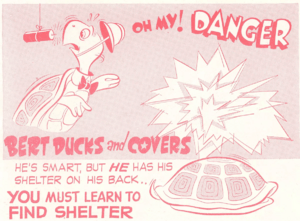Duck and Cover facts for kids
Duck and Cover is a suggested method of protection from nuclear weapons. Duck and Cover is a method where the person must lay face-forward towards a wall or under a table in the fetal position. Today it is used for earthquakes and tornados.
Images for kids
-
The Rest House of Hiroshima Peace Park, the basement of which Eizo Nomura was in on August 6, 1945 when Little Boy exploded overhead. The building was built as a kimono shop in 1929 and was one of the "about 50" other "fair", or moderately strong, reinforced concrete buildings in central Hiroshima that remained standing following the blast and firestorm and in good structural condition, due to having a high percentage of window area which relieved blast pressure on the structural frames.
-
Anything that can cast a shadow will protect that which is shadowed from being burnt. In this case a valve protected a portion of the bitumen coated wall of a gas holder from having a line-of-sight with the nuclear fireball whereas all unshadowed surfaces were lightened, akin to a near instant "sun fading" of the coating. A large number of these permanent markings were used, by extrapolating backward, to determine the exact point of detonation in the sky.
-
A man who was present at Nagasaki on August 9, 1945 during the dropping of the 20-kiloton Fat Man bomb; this photo displays 1st- and 2nd-degree burn injuries he experienced on his unclothed skin, the shoulder and arm, while the thin vest garment of clothing, a radiant barrier, that he was wearing at the time of the explosion completely protected his stomach and lower chest from experiencing similar burns. A clearer color restored version of this picture is also available.
-
An Operation Doorstep mother and daughter mannequin pair in an improvised basement lean-to shelter prior to testing in Upshot-Knothole Annie. To shelter-in-place in such an area would offer, in a number of outdoor dose rates, an adequate fallout radiation protection factor (PF) or "dose reduction factor" of 20 or more. More effective basement spaces did/do exist however, of "10 million" homes assessed in 1968, 500,000 US basements were found to have a PF-40.
-
In units of rads, this is a simplistic model (Gaussian) of a wind-blown fallout map, which depicts the unshielded ground level fallout gamma ray dose and dose rate contours expected to follow a 2 megaton land surface burst detonation, with 1 megaton of the yield coming from fission reactions. Because of radioactive decay, the dose rate contours (on the right) contract after fallout has arrived, but the total absorbed dose contours (left) continue to grow. A similar color version of the right panel, dose rate contour plot, for a 0.1 to 10 kiloton surface burst is also available. Acutely dangerous regions of fallout are accompanied by fallout particles which are large enough to be detected by eye during its falling out/deposition, that is, they are equal to or larger than the size of dust. All of the ARS deaths following the Chernobyl accident were due to external beta burns. The beta particle to gamma energy ratio is usually greater than 3 in the timeframe of fallout with the greatest threat to life. Protection from physical contact with the dust therefore greatly reduces radiation exposure. The beta decaying uranium-237 and neptunium-239, that are generated from the neutron capture of U-235 and Pu-239 respectively, are regarded as the leading hazardous radioisotopes in the first hour-to-week period following nuclear fallout, with Np-239 dominating "the spectrum for several days".
-
Students participate in a tornado drill, lining up along an interior wall and covering their heads. Tornado drills are an important element in tornado preparedness. Similar to other evidence based safety drills, they teach effective countermeasures and therefore increase survival rates if/when a tornado hits.








